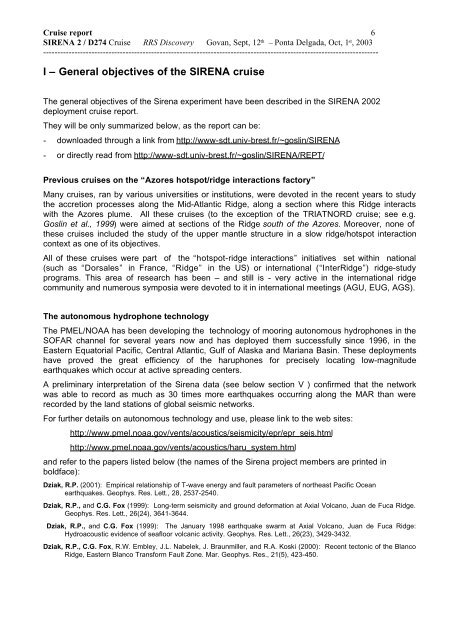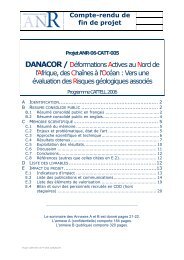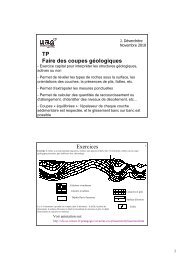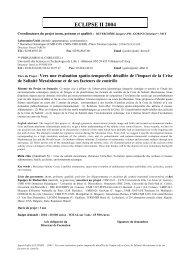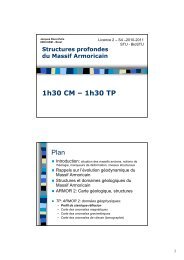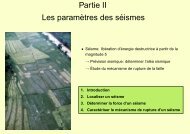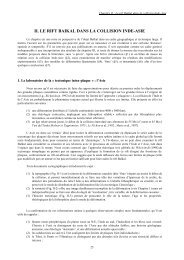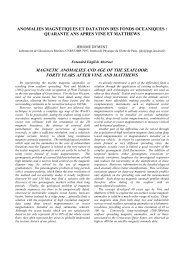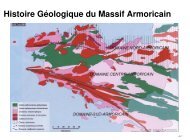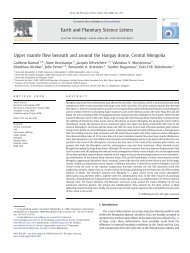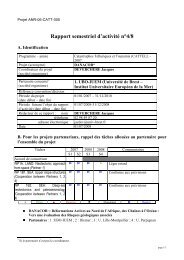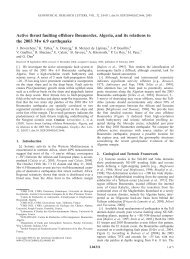<strong>Cruise</strong> report 6SIRENA 2 / D274 <strong>Cruise</strong> RRS Discovery Govan, Sept, 12 th – Ponta Delgada, Oct, 1 st , 2003----------------------------------------------------------------------------------------------------------------------I – General objectives of the SIRENA cruiseThe general objectives of the Sirena experiment have been <strong>des</strong>cribed in the SIRENA 2002deployment cruise report.They will be only summarized below, as the report can be:- downloaded through a link from http://www-sdt.univ-brest.fr/~goslin/SIRENA- or directly read from http://www-sdt.univ-brest.fr/~goslin/SIRENA/REPT/Previous cruises on the “Azores hotspot/ridge interactions factory”Many cruises, ran by various universities or institutions, were devoted in the recent years to studythe accretion processes along the Mid-Atlantic Ridge, along a section where this Ridge interactswith the Azores plume. All these cruises (to the exception of the TRIATNORD cruise; see e.g.Goslin et al., 1999) were aimed at sections of the Ridge south of the Azores. Moreover, none ofthese cruises included the study of the upper mantle structure in a slow ridge/hotspot interactioncontext as one of its objectives.All of these cruises were part of the “hotspot-ridge interactions” initiatives set within national(such as “Dorsales” in France, “Ridge” in the US) or international (“InterRidge”) ridge-studyprograms. This area of research has been – and still is - very active in the international ridgecommunity and numerous symposia were devoted to it in international meetings (AGU, EUG, AGS).The autonomous hydrophone technologyThe PMEL/NOAA has been developing the technology of mooring autonomous hydrophones in theSOFAR channel for several years now and has deployed them successfully since 1996, in theEastern Equatorial Pacific, Central Atlantic, Gulf of Alaska and Mariana Basin. These deploymentshave proved the great efficiency of the haruphones for precisely locating low-magnitudeearthquakes which occur at active spreading centers.A preliminary interpretation of the Sirena data (see below section V ) confirmed that the networkwas able to record as much as 30 times more earthquakes occurring along the MAR than wererecorded by the land stations of global seismic networks.For further details on autonomous technology and use, please link to the <strong>web</strong> sites:http://www.pmel.noaa.gov/vents/acoustics/seismicity/epr/epr_seis.htmlhttp://www.pmel.noaa.gov/vents/acoustics/haru_system.htmland refer to the papers <strong>liste</strong>d below (the names of the Sirena project members are printed inboldface):Dziak, R.P. (2001): Empirical relationship of T-wave energy and fault parameters of northeast Pacific Oceanearthquakes. Geophys. Res. Lett., 28, 2537-2540.Dziak, R.P., and C.G. Fox (1999): Long-term seismicity and ground deformation at Axial Volcano, Juan de Fuca Ridge.Geophys. Res. Lett., 26(24), 3641-3644.Dziak, R.P., and C.G. Fox (1999): The January 1998 earthquake swarm at Axial Volcano, Juan de Fuca Ridge:Hydroacoustic evidence of seafloor volcanic activity. Geophys. Res. Lett., 26(23), 3429-3432.Dziak, R.P., C.G. Fox, R.W. Embley, J.L. Nabelek, J. Braunmiller, and R.A. Koski (2000): Recent tectonic of the BlancoRidge, Eastern Blanco Transform Fault Zone. Mar. Geophys. Res., 21(5), 423-450.
<strong>Cruise</strong> report 7SIRENA 2 / D274 <strong>Cruise</strong> RRS Discovery Govan, Sept, 12 th – Ponta Delgada, Oct, 1 st , 2003----------------------------------------------------------------------------------------------------------------------Fox, C.G. (2000): U.S. NOAA underwater acoustic environmental monitoring efforts. Proceedings of the Fifth EuropeanConference on Underwater Acoustics, ECUA2000, M.E. Zakharia, P. Chevret, and P. Dubail (eds.), Lyon, France,2000, 749-754.Fox, C.G., and R.P. Dziak (1999): Internal deformation of the Gorda Plate observed by hydroacoustic monitoring. J.Geophys. Res., 104(B8), 17,603-17,615.Fox, C. G., Matsumoto, H. and Lau, T.K.A (2001): Monitoring pacific Ocean seismicity from an autonomous hydrophonearray. J. Geophys. Res., 106, 4183-4206.Johnson, H.P., H. Hutnak, R.P. Dziak, C.G. Fox, I. Urcuyo, C. Fisher, J.P. Cowen, and J. Nabelek (2000): Earthquakeinducedchanges in a hydrothermal system at the Endeavour Segment; Juan de Fuca Ridge. Nature, 407, 174-177.Orcutt, J., E. Bernard, C.-S. Chiu, C. Collins, C. deGroot-Hedlin, R. Dziak, C. Fox, W. Hodgkiss, W., Kuperman, J.Mercer, W. Munk, R. Odom, M. Park, D. Soukup, R. Spindel, F. Vernon, and P. Worcester (2000): Long-termobservations in acoustics. The Ocean Acoustic Observatory Federation. Oceanography, 13(2), 57-63.Slack, P.D., C.G. Fox, and R.P. Dziak (1999): P wave detection thresholds, Pn velocity estimates, and T wave locationuncertainty from oceanic hydrophones. J. Geophys. Res., 104(B6), 13,061-13,072.I-I Rationale for the deployment of autonomous hydrophonesSix haruphones were deployed in the SOFAR channel in the North Atlantic during the SIRENAcruise (see the general track map in section III for the locations of the mooring sites and for trackssailed during the Sirena1 & Sirena2/D274 cruises). At water depths around 1000 meters, acousticwaves generated in the water column by earthquakes – and by marine mammals - propagate tovery long distances with a very low signal attenuation. The moorings are located on both flanks ofthe Mid-Atlantic Ridge (MAR), north of the Azores, between latitu<strong>des</strong> 40°N and 50.5°N (that isbetween the Azores Plateau and a major structural discontinuity south of the Gibbs Fracture Zone).An other hydrophone network, similar to the one which was deployed during the SIRENAcruise, has been deployed south of the Azores by the PMEL/NOAA between latitu<strong>des</strong> 17°N and35°N. This network has been operating since Feb. 99 and funding for its operation goes on till2006.It should be noted in this respect that the Azores Plateau is globally shallower than theSOFAR channel in the North Atlantic, especially as the apex of the SOFAR channel was found to beunusually deep in the area of survey, exceeding 1000 meters at some of the mooring sites. Ittherefore acts as a "barrier" to the sound propagation of the acoustic waves generated byearthquakes whose epicenters are located south of the Plateau. The existence of such a barrierexplains that the network which is presently operated by PMEL/NOAA can observe only very few ofthe events which originate north of the Azores Plateau. This problem is the main reason whichwarranted the SIRENA experiment.The SIRENA experiment objectives (two main objectives and an ancillary one) are based onan accurate determination of the epicenters of the numerous earthquakes occurring along the Mid-Atlantic Ridge. Such a precise determination is not achieved by global seismograph networks,which record 30 to 50 times less numerous earthquakes and fail to locate most of the events with asufficient accuracy. Such goals (the recording of numerous low-magnitude earthquakes and theprecise determination of their locations) are made possible by the data recorded by the hydrophonenetwork.The objectives are the following:I.I.1 - To contribute to the understanding of active processes at the axis of mid-oceanicridges.Recent studies of the accretion processes active at the axes of slow ridges, whether based onfield studies (e.g. Thibaud et al., 1998) or on the interpretation on analog or numerical models (e.g.


